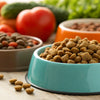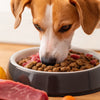Is Kibble Really That Bad for Dogs? Exploring the Truth About Your Dog's Diet
- Houndsy
Table of Contents
- Introduction
- Understanding Kibble: What Is It and How Is It Made?
- The Pros of Feeding Kibble
- The Cons of Feeding Kibble
- Choosing the Right Kibble
- Alternatives to Kibble
- Enhancing Your Dog’s Diet
- Conclusion
Introduction
Have you ever watched your pup happily munching away on their kibble and wondered, "Is this really the best thing for them?" You’re not alone! In an era where pet owners are increasingly concerned about the nutritional quality of their pets’ food, the debate around kibble versus other diets has gained significant traction. Recent studies reveal that a staggering 51% of dogs are classified as obese, prompting us to reconsider what we’re putting in their bowls.
As dog lovers, we want what’s best for our furry companions. But with so many opinions floating around about pet nutrition, understanding the implications of a kibble diet can be overwhelming. This blog post will explore the nutritional value of kibble, its potential downsides, and alternative feeding options. By the end, we hope to equip you with knowledge to make informed decisions about your dog’s diet.
In this comprehensive guide, we will delve into the following aspects:
- What exactly kibble is and how it's made.
- The pros and cons of feeding kibble to your dog.
- Factors to consider when choosing a kibble brand.
- Alternative feeding methods to explore.
- Practical tips for enhancing your dog’s diet, whether they eat kibble or not.
Let's dive deeper into the question: Is kibble really that bad for dogs?
Understanding Kibble: What Is It and How Is It Made?
Kibble is a type of dry dog food that is commercially produced and has been a staple in pet diets since the 1950s. It’s made from a blend of ingredients, including meat, grains, vegetables, and added vitamins and minerals. The ingredients are cooked at high temperatures and then extruded into small, bite-sized pieces.
The Process of Making Kibble
- Ingredient Selection: Kibble is typically composed of proteins (like chicken or beef), grains (such as corn or barley), vegetables, and essential nutrients. The quality of these ingredients can vary greatly.
- Extrusion Cooking: This process involves cooking the ingredients under high pressure and temperature. While this method kills harmful bacteria, it can also destroy some nutrients, which are later added back artificially.
- Shaping and Coating: Once cooked, the mixture is shaped into kibble pieces, which are then coated with fats and oils to enhance palatability.
- Packaging: Finally, the kibble is packaged and shipped out, with a low moisture content (around 10%), allowing for a long shelf life.
While the process is efficient, it raises questions about nutritional value.
The Pros of Feeding Kibble
Despite the ongoing debate, there are some undeniable benefits to feeding kibble:
- Convenience: Kibble is easy to store, measure, and serve. It doesn't require refrigeration and can be left out without spoiling.
- Cost-Effectiveness: Generally, kibble is more affordable compared to fresh or raw diets, making it accessible for many pet owners.
- Balanced Nutrition: High-quality kibbles are formulated to provide a complete and balanced diet, containing essential nutrients and vitamins that dogs need.
- Dental Health: The crunchiness of kibble can help scrape away plaque and promote better dental health.
- Portion Control: Kibble allows for easy measurement, helping to manage your dog's weight effectively.
The Cons of Feeding Kibble
While there are advantages, there are also notable downsides to feeding kibble:
- Quality Variations: Not all kibbles are created equal. Many lower-quality brands use fillers like corn and soy, which can lead to allergies and digestive issues.
- Highly Processed: The high-temperature cooking process can deplete essential nutrients, leading to a reliance on artificial additives to ensure nutritional adequacy.
- Low Moisture Content: With about 10% moisture, kibble can lead to dehydration, especially if dogs don’t drink enough water.
- Potential for Allergies: Common allergens in kibble, such as grains and by-products, can trigger sensitivities in some dogs.
- Digestibility Issues: The high carbohydrate content can lead to digestive problems, including gas, bloating, and diarrhea.
Choosing the Right Kibble
If you decide to feed your dog kibble, choosing a high-quality brand is crucial. Here’s what to look for:
- Named Meat as the First Ingredient: Ensure the first ingredient is a specific meat source (e.g., chicken or beef) rather than a generic term like "meat meal."
- Healthy Fats: Look for sources of fat, such as fish oil or flaxseed, which provide essential fatty acids.
- No Artificial Additives: Avoid kibble with artificial colors, flavors, or preservatives.
- Minimal Fillers: Check for excessive amounts of corn, wheat, or soy, especially if your dog has a sensitive stomach.
- Moderate Sodium Content: Look for kibbles with sodium sourced from natural ingredients rather than excessive levels.
Alternatives to Kibble
As pet owners become more informed, many are exploring alternatives to kibble. Here are a few popular options:
- Fresh or Homemade Diets: These diets can be tailored to meet your dog’s specific needs but require careful preparation to ensure balanced nutrition.
- Raw Diets: Some pet owners advocate for raw feeding, which mimics a dog’s ancestral diet. However, raw diets require meticulous handling to avoid contamination.
- Freeze-Dried or Dehydrated Food: These options offer convenience and tend to retain more nutrients compared to kibble.
- Mixed Diets: Combining kibble with fresh or raw food can provide the benefits of both worlds.
Enhancing Your Dog’s Diet
Whether you stick with kibble or explore other options, there are ways to enhance your dog's diet:
- Add Fresh Toppers: Mix in dog-safe fruits or vegetables like carrots, blueberries, or cooked lean meats to boost nutrition and flavor.
- Hydrate Kibble: Add water or low-sodium bone broth to make kibble easier to digest and keep your dog hydrated.
- Consider Rotational Feeding: Switching between different kibble proteins or adding fresh foods can help provide variety and prevent boredom.
Conclusion
So, is kibble really that bad for dogs? The answer isn’t black and white. Kibble, particularly high-quality varieties, can provide a balanced diet for many dogs. However, it’s essential to consider the potential downsides, including ingredient quality and processing methods.
As responsible pet parents, we must assess our dogs' individual needs and preferences when it comes to food. Whether you choose kibble, fresh food, raw diets, or a combination, what matters most is providing your dog with a nutritious, balanced diet that keeps them healthy and happy.
Are you ready to elevate your dog’s feeding experience? Explore our Houndsy Kibble Dispenser—designed to simplify and enhance your pet's mealtime. With perfect portion control and a stylish design, feeding becomes a delightful ritual rather than a chore.
FAQ
1. Can I mix kibble with wet food?
Yes, mixing kibble with wet food can add moisture and flavor, making it more appealing to your dog.
2. How do I know if my dog's kibble is high-quality?
Look for a named meat as the first ingredient, no artificial additives, and minimal fillers.
3. Are there specific dog breeds that benefit more from kibble?
Generally, all breeds can benefit from kibble, but the quality and formulation may vary based on size, age, and activity level.
4. Is it safe to switch my dog from kibble to a raw diet?
Switching diets should be done gradually and with guidance from your veterinarian to ensure that your dog’s nutritional needs are met.
5. How can I ensure my dog stays hydrated on a kibble diet?
Always provide fresh water and consider adding water or bone broth to kibble to enhance hydration.
Explore our Houndsy Kibble Dispenser to make your dog's feeding experience both convenient and enjoyable!












